
Bamboos: plant, pruning, maintain
Contents
Bamboos in a nutshell
- Bamboos bring the exotic touch to the garden
- They are evergreen but can be invasive
- Their growth is very rapid
- Easy to maintain, they are hardy and resilient
- They can be used as hedges, in borders, as specimens, or in pots
A word from our expert
With their graphic and evergreen foliage, rustling at the slightest breeze, their robust and straight culms, bamboos structure the garden even in winter, bringing an extremely exotic, zen or contemporary touch all year round.
From potted bamboo to giant bamboo, including dwarf bamboo, the term bamboo, while evoking for Asian cuisine enthusiasts a restaurant in Paris, encompasses an immense diversity of genera, more or less invasive species, and varieties of plants. Forget the “Lucky Bamboo” or “bamboo of luck” (Dracaena sanderiana) from florists and the Sacred Bamboo (Nandina domestica): despite their common names, they have nothing to do with the genus!
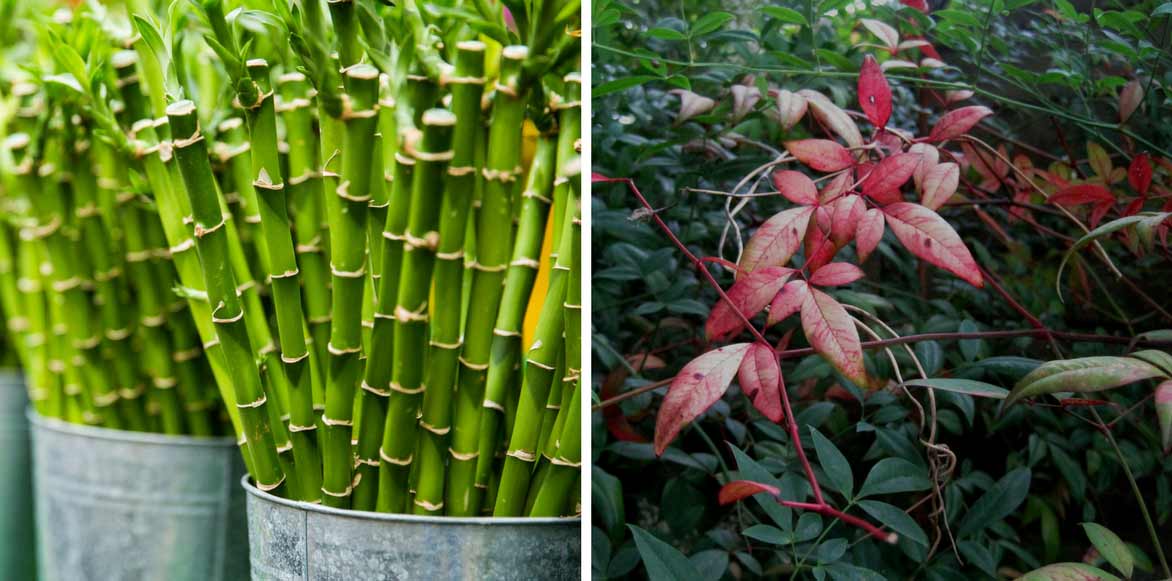
Whether they are running bamboos like Phyllostachys, less invasive or non-invasive (cespitose) like Fargesia, they all create highly exotic scenes.
In the garden, they settle in quickly, boasting a rapid growth they quickly form beautiful privacy or windbreak hedges, noise-reducing green screens, exotic forests, light yet structural flowerbeds, or lush ground covers. Dwarf bamboos also work wonders as low hedges, as ground cover or grown in pots on a terrace or balcony. Additionally, dry bamboos will serve as supports for your clematis or dahlias.
They thrive in non-burning sun, as well as in shade, in any soil that remains cool.
Do not be fooled by their tropical plant appearance: while there are a few frost-sensitive species (-10°C), most bamboos are capable of withstanding frosts sometimes down to -25°C and acclimatise in all regions.
Want to purchase bamboos online? Discover our range of bamboos of all sizes and choose from our exceptional collection the one that will give your garden or terrace the spirit of the Land of the Rising Sun!
Botany
Botanical data
- Latin name Phyllostachys, Sasa, Arundinaria, Fargesia, Chusquea...
- Family Poaceae
- Common name Bamboo
- Height 0.70 to 10 m and +
- Exposure Sun, partial shade
- Soil type Neutral, acidic
- Hardiness -10°C to -25°C depending on varieties
Bamboos are types of woody grasses from the Poaceae family, native to the temperate and subtropical forests of Asia (from China and Japan where they are highly valued by pandas), Africa, and Central and South America, where they can be found up to 3000 m in altitude. Bamboos have largely acclimatised in our European gardens. The term bamboo encompasses a large number of genera, species, and varieties.
There are 80 genera and over 1000 species of bamboo. Their height varies depending on the species. Bamboos are classified into three size categories, from dwarf bamboo like Pleioblastus viridistriatus to giant ones like Phyllostachys vivax: dwarfs measure from 20 cm to 1.50 m in height, small and medium ones from 1.50 m to 10 m, and giants 10 m and above.
They are also classified according to their growth type: spreading species like Phyllostachys, which multiply rapidly through their rhizomes to the point of becoming invasive, and whose expansion can be contained by a rhizome barrier, and non-spreading bamboos known as “cespitose” like Fargesia, which grow in a compact clump and, unlike other bamboos, are non-invasive. The root system of bamboos is very dense but shallow.
Non-spreading bamboos (Fargesia) with cespitose rhizomes develop slowly around and at the centre of the clump, they grow slowly, thicken but do not spread. There are also lesser-known, slightly spreading species like semiarundinaria fastuosa with an extraordinarily vertical columnar habit.
Spreading bamboos quickly form an inextricable network of underground rhizomes that grow in line, giving rise to new culms. These rhizomes can grow several metres in a year. This gives bamboo the reputation of being a born coloniser. Highly spreading bamboos are capable of covering an area of 20 square metres in just 10 years. Under optimal growing conditions, some bamboos can grow several centimetres a day, up to 1 m!
Ground-cover and medium varieties grow relatively quickly and reach their adult size in a few years. Giant varieties reaching over 10 m in height will only reach full development in 7 to 10 years.
Bamboos display a bushy habit that is both dense and upright, more or less erect at the tips, sometimes trailing. Cespitose bamboos form a compact and tight clump that flares out at the top. Shoots or young shoots develop on the rhizomes, giving rise to thin and robust canes known as culms. Some species have edible young shoots once boiled.
These culms or canes, thin or thick like poles, rise from a few centimetres to over 25 m high depending on the species. With variable diameters (from a few millimetres to nearly 20 cm), each culm is formed from a stack of hollow tubes partitioned at intervals by nodes. These internodes, more or less swollen depending on the species, give flexibility to the cane. The inner tissue is much less hard than the stem. While the canes are perfectly straight in most species, some bamboos produce twisted culms at the lower part, like Phyllostachys zig-zag.
The smooth or channelled culms divide into slender branches bearing leaves. Young culms are sometimes covered with a white bloom that disappears quickly. They exhibit various appearances.
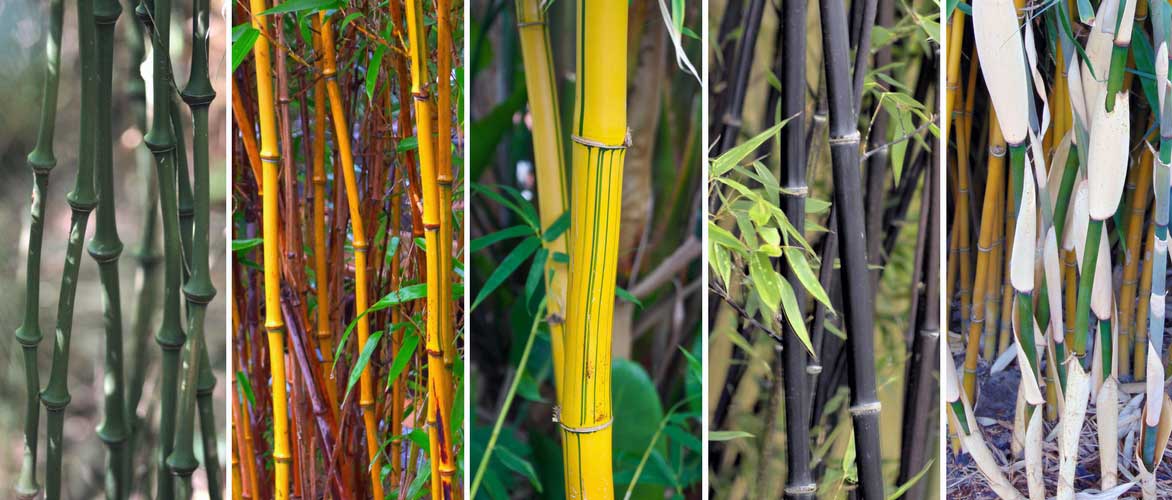
The great diversity of bamboos is also expressed through their very graphic canes. Chimonobambusa tumidissinoda / Phyllostachys aureosulcata spectabilis / Phyllostachys vivax aureocaulis / Phyllostachys nigra / Fargesia robusta Wolong
Their colours range from intense medium green, to lime green, olive green, pink-yellow, bright yellow, or almost golden to black, mahogany, or even steel blue. Often, the culms gradually change colour over time and with the sun, shifting from green to sulphur yellow, grey, pink, or red. Thus, canes of different ages, displaying varied shades, coexist in beautiful harmony.
Some culms take on a zebra or bicolour appearance and are marked along their length by subtle stripes, sometimes a contrasting colour ring can be observed under each node.
They are sometimes adorned with persistent cauline sheaths that remain attached to the canes for a few months before falling, offering beautiful contrasting effects between the colour of the sheath, that of the culms, and that of the foliage.
These canes are resistant to strong winds, possess a certain flexibility and rarely break, except for Phyllostachys vivax whose thin walls are fragile . A beautiful flexibility that makes bamboos useful, once dried, as stakes, structural bases for light constructions, furniture making, flooring, musical instruments…
The main attraction of bamboos lies in their ample foliage with an unusual graphic quality, rustling at the slightest breath of wind.
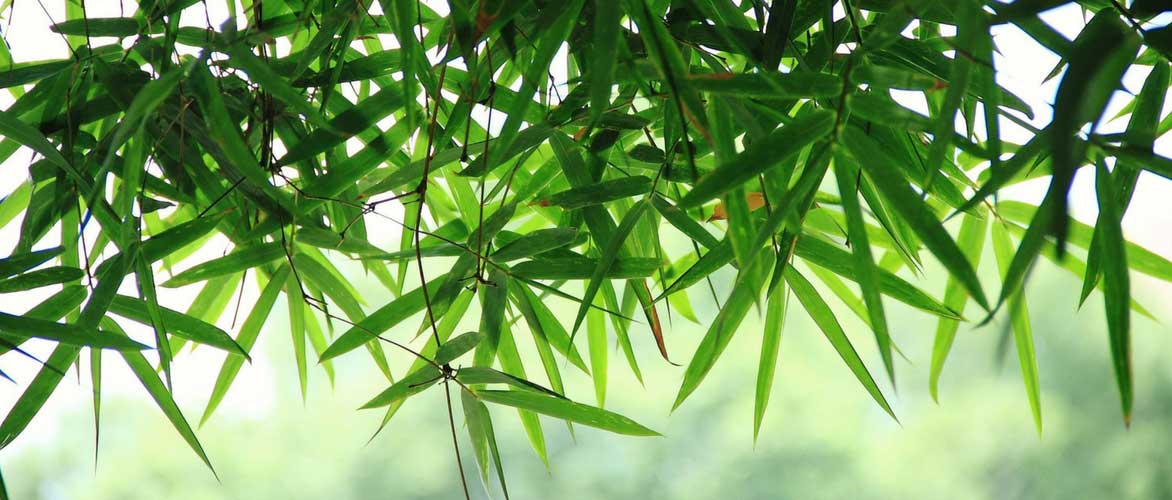
This persistent foliage is distributed over almost the entire height of the culms. It is often densely branched towards the top. The branches, themselves divided into ramifications, emerge from the nodes. Bamboos always maintain a bushy but light silhouette. The leaves, measuring from 2 to 25 cm long, more or less narrow and lanceolate, tapering at their tips, are grouped in dense tufts along the secondary stems. Their colour varies according to species and varieties, from dark green, striped or edged with beige or yellow in the first frosts. They sometimes take on an orange hue with age. The leaves dry, fall but are quickly renewed.
The flowering of bamboos is of little interest. It is rare, irregular, and unpredictable. It is a bad sign and often heralds the death of the plant: the culms dry out and die after flowering.
Robust, perfectly hardy (down to -25 °C depending on species) and truly undemanding regarding exposure, they prefer partial shade but tolerate sun well as long as moisture is not lacking.
While bamboos thrive in any good garden soil, the quality and moisture content of the soil nevertheless condition their good development. They all appreciate moisture in summer, warmth, and fertile soils, and grow quickly if these conditions are met. They will quickly colonise any moist soil, whether acidic or neutral, as long as it is rich, light, and cool, without excess lime. They will establish less quickly in poor soil.
If they are the undisputed stars of Asian-inspired gardens, bamboos adapt to many styles, from the most contemporary to the most exotic, from the most zen to the wildest.
Perfect in isolated clumps, bamboos also form majestic vegetative screens that act as windbreaks or privacy screens, small hedges, or ground covers. Planted en masse, they quickly form forests of elegant exoticism.
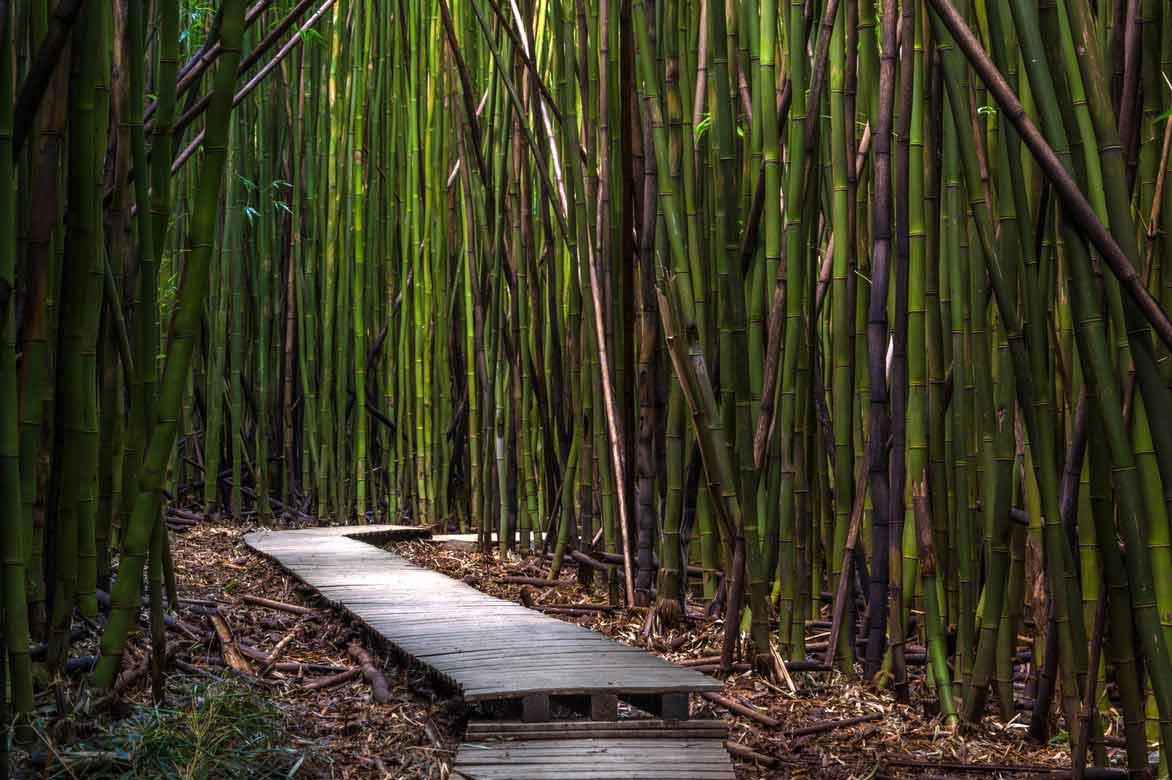
Spreading bamboos, imposing, offer the garden a very architectural dimension. Non-spreading species (cespitose bamboos) can be easily planted in small gardens or in a large pot on the balcony or terrace.
Bamboo is indestructible and survived the Hiroshima bomb.
Read also
How to divide and multiply your bamboos?Species and main varieties
There is not just one bamboo but many bamboos. Bamboos offer an immense diversity of genera, species, and varieties. Between the architectural running bamboos, such as Phyllostachys, known for their rapid growth, and the non-running bamboos, referred to as “cespitose” for their non-invasive nature, it can be difficult to make a choice!
In the family of running bamboos, alongside the most well-known Phyllostachys, we find Semiarundinaria, Pleioblastus, Sasa, Chimonobambusa, and Shibatea.
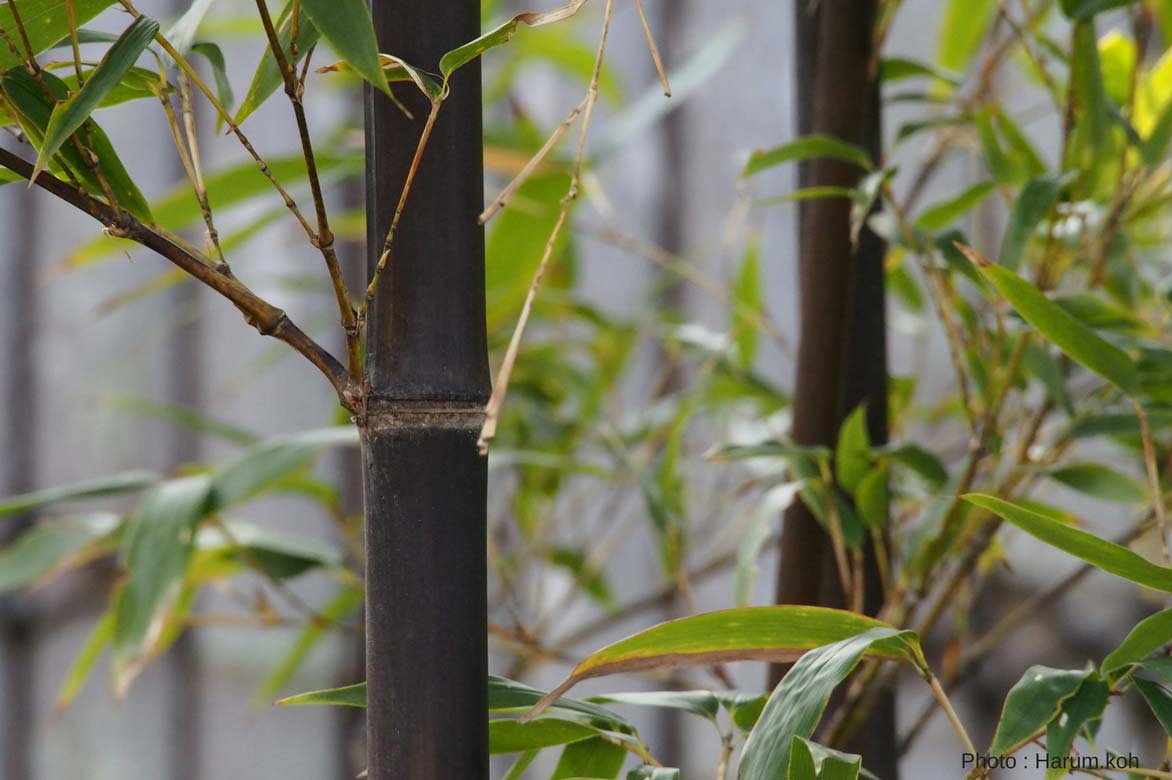
Phyllostachys nigra or Black Bamboo: a highly appreciated variety in gardens
Among the cespitose (non-running) bamboos, we know the famous Fargesia, but there is also Yushania, Chusquea, Thamnocalamus, and Indocalamus, which are certainly less known but equally interesting.
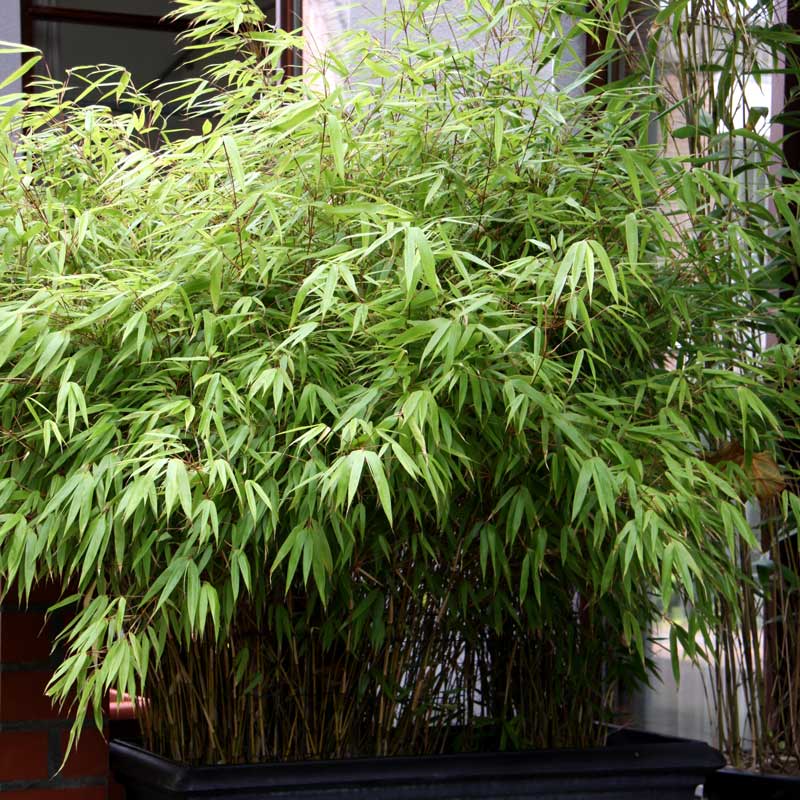
Fargesia is the ideal bamboo for pot cultivation and small gardens
Running bamboos have one flaw: in suitable soil, they spread at lightning speed and require the installation of a rhizome barrier.
Check our advice sheet to find out how to install a rhizome barrier.
With little to no maintenance, bamboos are mostly very hardy and bear remarkable, colourful canes that are very graphic (like the stunning dark culms of Phyllostachys nigra or Black Bamboo or the completely bright yellow of Phyllostachys aureosulcata ‘Aureocaulis’) and beautiful evergreen green foliage sometimes variegated with gold or beige.
We offer a large selection of bamboos of all sizes, for all gardens and even suitable for pot cultivation, discover our most beautiful varieties from the most classic to the more unusual!
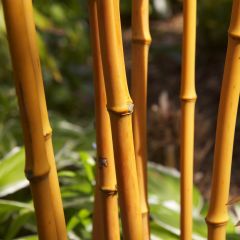
Golden Bamboo - Phyllostachys aurea
- Height at maturity 6 m
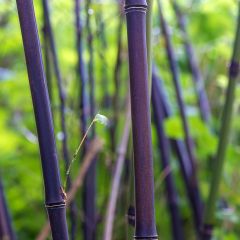
Black bamboo - Phyllostachys nigra
- Height at maturity 6 m

Fargesia robusta - Non-running Bamboo
- Height at maturity 4 m
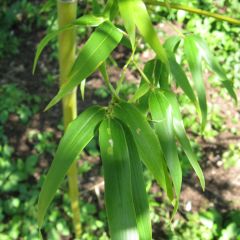
Semiarundinaria fastuosa - Medium-sized Bamboo
- Height at maturity 7 m

Fargesia robusta Pingwu - Non-running bamboo
- Height at maturity 4,50 m
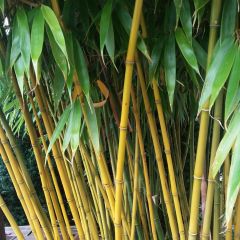
Fargesia robusta Wolong
- Height at maturity 5 m
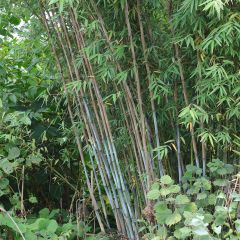
Fargesia papyrifera Blue Dragon - Non-running bamboo
- Height at maturity 6 m
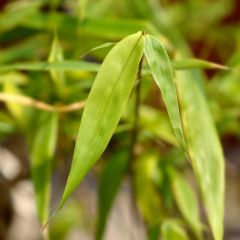
Fargesia scabrida Asian Wonder - Non-running Bamboo
- Height at maturity 3,50 m
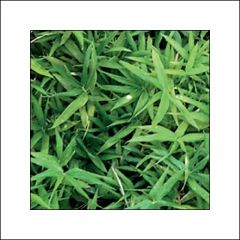
Pleioblastus viridistriatus Vagans - Dwarf Bamboo
- Height at maturity 70 cm
Discover other Bamboos
View all →Available in 2 sizes
Available in 3 sizes
Available in 3 sizes
Available in 1 sizes

Available in 3 sizes
Available in 2 sizes
Available in 1 sizes
Available in 2 sizes
Available in 1 sizes
Available in 1 sizes
Young plantation
Where to Plant Bamboo?
Perfectly hardy, bamboo withstands cold well, some down to -20°C and sometimes even lower. They thrive all over France. Protect them from cold, dry winds to which they are quite sensitive.
They enjoy partial shade but tolerate full sun well. Bamboo prefers a neutral or acidic soil without excessive lime, ideally rich, cool, and well-drained. They like slightly moist soil in summer, but hate having their roots in water during winter: waterlogged soil would lead to fatal rot.
Before planting, keep in mind that running bamboo can quickly become invasive. So think carefully about their placement and the space you wish to allocate them. You can limit the spread of their running rhizomes by defining their area from the start with a root barrier made of polypropylene, planted vertically around the young plant.
Running bamboos, such as Phyllostachys, are impressive, reaching nearly 10 metres in height. Make sure to provide them with ample space!
Fortunately, for small spaces or large pots, there are cespitose non-invasive bamboos that are just as ornamental and do not require control with a root barrier. Dwarf bamboos typically do not exceed 1.5 m and can also be grown perfectly well in pots. In the garden, they work wonderfully as low hedges and ground cover.
Depending on their height at ripeness, they will form dense and decorative hedges, privacy screens or windbreaks, and persistent backdrops whether in the ground or in large containers on the balcony or terrace. They can also be grown as isolated clumps.
When to Plant Bamboo?
Bamboo planting is ideally done at the end of summer and during autumn, from late August to October. You can also plant between March and April in the northern regions of the Loire or between September and November in the southern regions. In any case, plant bamboo in spring after the last frosts or in autumn after the heat of summer.
How to Plant
Planting in the ground or in pots is a crucial step as it determines the establishment and proper development of your bamboo, which must never lack water. Bamboo will grow more or less quickly depending on the growing conditions.
- In the Ground
In a wide and deep hole, install the root barrier that will control the spread of running varieties. It should extend 5 cm above the ground. Place the root ball in the centre of the hole. Backfill with the garden soil extracted, adding good potting soil and manure. Bamboo needs a lot of water to establish, so water generously at planting and then very regularly during the first year following planting, especially in summer when the soil is very dry. Subsequently, their fallen dry leaves will form a natural mulch at the base, but during the first few years, do not hesitate to add a mulch of wood chips or pine bark.
- In Pots:
Bamboo tolerates pot cultivation very well, provided you keep up with watering. Choose your species carefully (some too vigorous could quickly break the pot) and prefer non-invasive or slow-growing bamboos. Plant them in a sufficiently large pot of at least 50 cm deep and in a rich (planting soil or rose soil) and well-draining mix. Give them a sunny spot that is not scorching and sheltered from drafts. Bamboo in pots must never lack water; monitor watering closely, especially during prolonged dry spells.
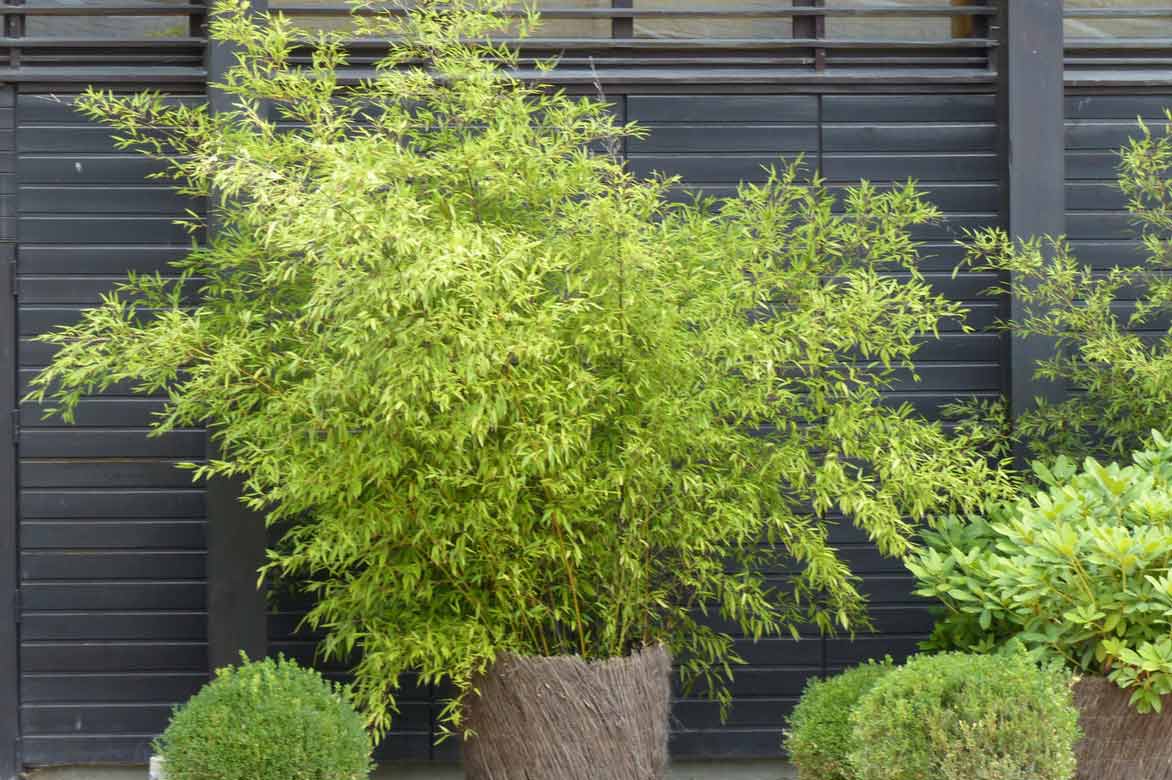 Phyllostachys aurea in a pot[/caption>
Phyllostachys aurea in a pot[/caption>
Read also
To grow bamboo in a potMaintenance, pruning and care
Once well established, the bamboos require virtually no maintenance but they are greedy for water. In summer and during dry spells, water generously at the base and shower the foliage in the evening. To root well and grow, the young plants require regular watering during the first two years after planting.
Potted plants also need increased monitoring of watering; be careful not to let the soil dry out too much between waterings, as they can drink up to 5 litres a day in hot weather. In the first few years, a mulch will help keep the soil moist in summer. However, over time, you will notice that the bamboos mulch themselves, thanks to their dry leaves, which decompose very slowly.
→ Learn more in our advice sheet How to water a bamboo in a pot?
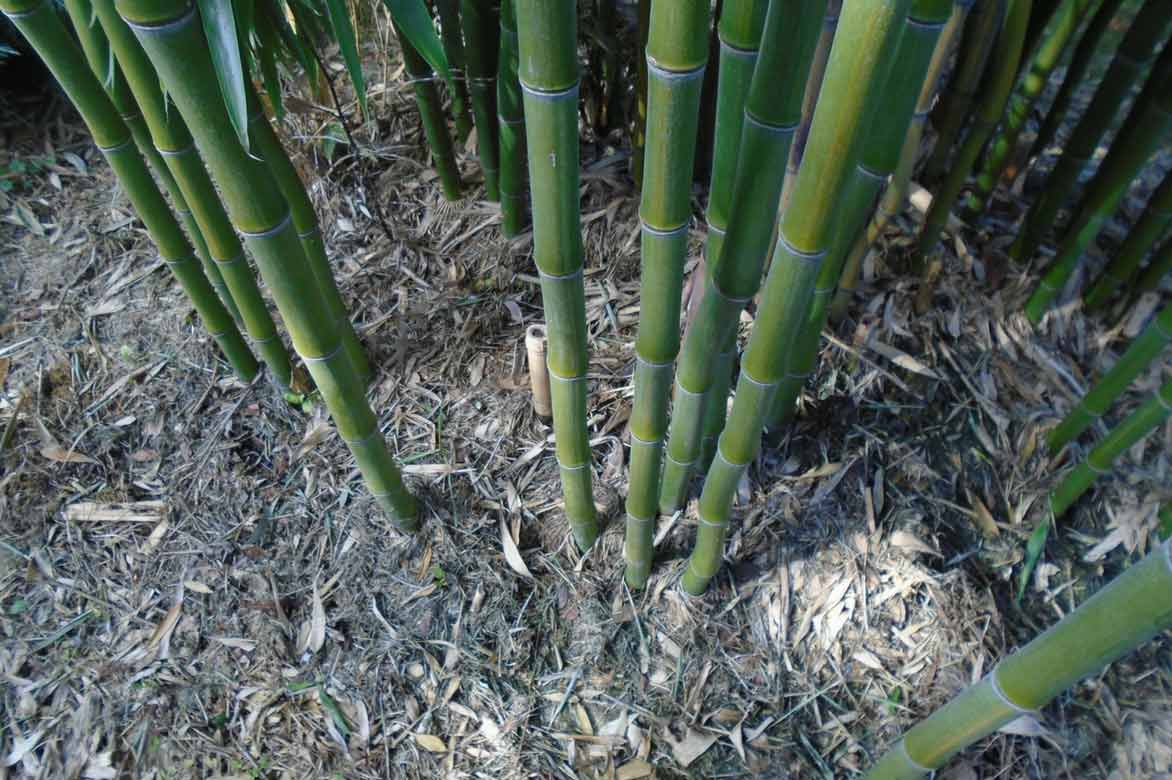
Leave the bamboo leaves at their base: they “self-mulch” naturally!
Bamboos appreciate well-fertile soil: at the beginning of spring, you can add rich compost or a special bamboo fertiliser high in nitrogen, twice a year for bamboos grown in pots. If the leaves tend to yellow, this may indicate an excess of lime in the soil: add heather soil to the surface.
Pruning bamboos is not necessary. However, they tolerate being pruned with shears at the end of summer, around August-September, either to shape them according to your desires, limit their growth, or to remove dry canes (once well dried, they can be used as stakes). Every year, cut at the base the dry culms, the less vigorous ones, and the most troublesome. This maintenance pruning will allow the plant to develop entirely new and denser foliage. However, be aware that once pruned, the canes do not regrow.
In winter, do not hesitate to clear the canes of snow: even though the canes are remarkably flexible, they may break under the weight.
Diseases and potential pests
Bamboos are not fragile and are resistant to most diseases and parasitic threats. However, they can become more vulnerable when weakened by excess water and a lack of nutrients.
When the weather is warm and humid, potted bamboos are sometimes susceptible to attacks from mealybugs that feed on the sap and leave white, farinose or cottony clusters on the plant. The leaves eventually turn yellow and fall off, potentially leading to the plant’s demise. Spraying a mixture of vegetable oil (rapeseed or olive oil), 90° alcohol, and black soap can help suffocate them. In cases of severe infestation, cut and burn the affected parts. Red spider mites can also cause yellowing and drying of the leaves, which eventually fall off. Treat with an acaricide.
→ Learn more in our advice sheet Diseases and parasites of bamboo
Multiplication
Rapidly spreading bamboos make it easy to take advantage of this natural trend to acquire new plants at a lower cost. Propagation is carried out in spring, in March-April, by dividing clumps, and should be done on clumps that are at least three years old. Intervene when the soil is sufficiently moist to extract the clumps more easily. Propagation by cutting rootstocks is also possible for certain running species, but success is too unpredictable to be recommended.
Clump division:
- Using a sharp spade, take a good clump from a group with at least 2 culms (ideally 3 to 5 culms) from the periphery of the main clump.
- Shorten the existing culms by one-third of their length while always keeping some foliage (without leaves, the clumps taken will not recover).
- Place the clump in a planting hole enriched with rich compost.
- Backfill, firm down, and mulch.
- Stake the plant at three points to secure it firmly (tall bamboos have a significant wind resistance).
- Water generously and then keep the soil moist but not waterlogged.
- Regularly spray water on the foliage during dry or windy weather, in the evening or morning, to prevent leaf desiccation and ensure good recovery.
Once taken, the tall bamboos will return to their juvenile stage. The new culms that emerge will be smaller in size and diameter. It will take several years before the dimensions of the mother plant are regained.
Associate
With their elegant foliage, sometimes variegated with green, cream, or yellow, their graphic silhouette, bamboos often stand alone, yet they lend themselves to multiple uses. They always bring brightness, movement, and verticality to a decor.
They allow for maintaining a beautiful garden even in winter, as frost enhances their elegant silhouette and evergreen foliage.
Undisputed stars of Asian-inspired gardens, bamboos integrate into all gardens, whether contemporary, zen, exotic, wild, or natural. Some, like Phyllostachys atrovaginata ‘Green Perfume’, particularly suited to wet areas, even add verticality to aquatic scenes in a water garden alongside astilbes, carex, bulrushes, goat beards, or giant gunneras.
Used in isolated clumps to structure a shrub bed, bamboos also serve as sound barriers, windbreaks, or privacy screens to mask an unsightly view, small free or trimmed hedges that are always green, or ground covers under very ornamental trees. They will provide refreshing shade for bush hydrangeas. Their light silhouettes will offer a lovely shape contrast with the more compact camellias.
In a more shrubby bed, they accompany sacred bamboo, spindle trees, or a Loropetalum. Their culms serve as natural supports for clematis.
Planted in numbers, thanks to their rampant growth, they quickly create forests with lush vegetation that are very exotic in appearance.
Easy to mix with each other or to associate with other Asian plants, such as Japanese grasses, Japanese maples, or mountain laurels, they also enjoy the company of hostas, Chinese palms, or flowering dogwoods, tree ferns. The large grasses like pennisetums, pampas grasses, or miscanthus will dress the base of their culms. Cannas or giant dahlias like the Dahlia imperialis will rise to flower among their foliage.
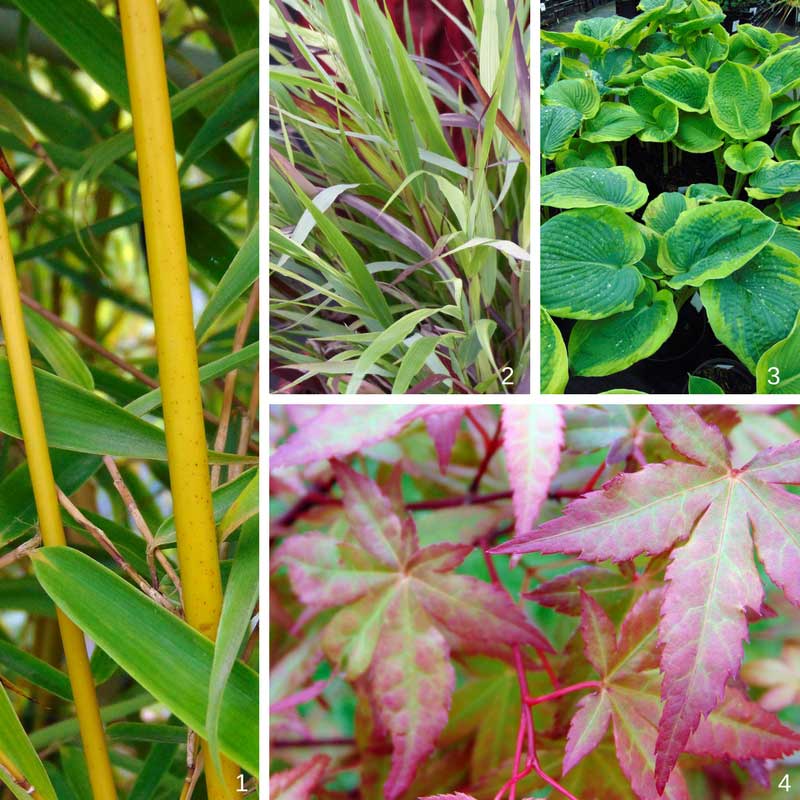
1) Fargesia robusta Campbell – 2) Hakonechloa macra Beni Kase – 3) Hosta sieboldiana Frances Williams – 4) Acer palmatum Redwine
Useful resources
- Discover our wide range of bamboos, selected for their ornamental qualities as well as for the non-invasive nature of certain species!
- Founded in 1856, the Bambouseraie d’Anduze in the Cévennes hosts a great many varieties of dwarf and giant bamboos.
- Discover 6 bamboos to grow in pots.
- Discover the bamboos with decorative foliage!
- Our advice sheet: How to water a bamboo in a pot properly?
- Discover our selection of 6 fast-growing bamboos.
- Discover our series on travelling plants: bamboo.
- Our plant sheet: Bambusa, planting, growing.
- Find our tips on: How to create a bamboo hedge?
- Discover why a bamboo flowers, and what to do?
- Subscribe!
- Contents































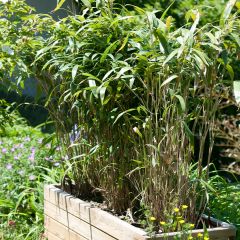
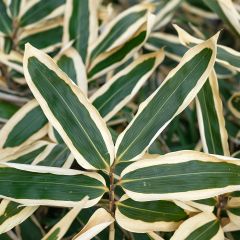

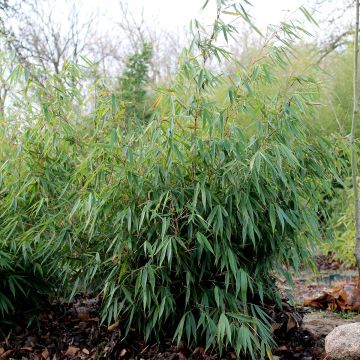
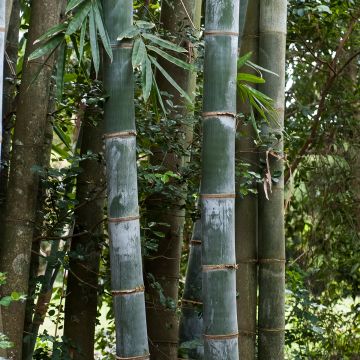
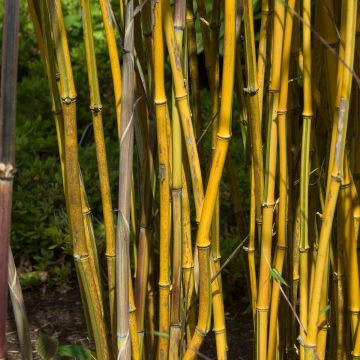

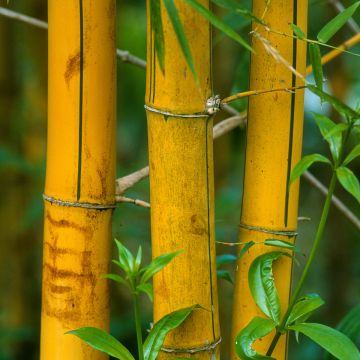


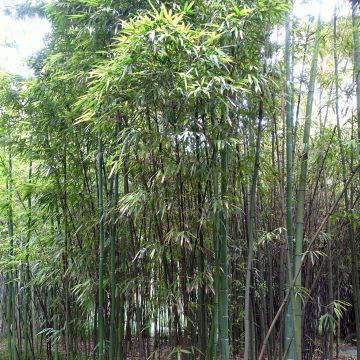
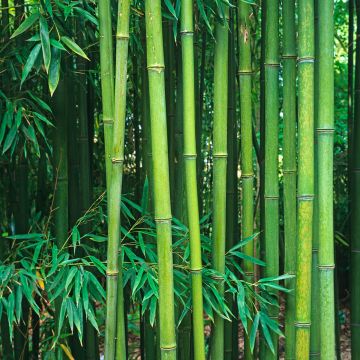
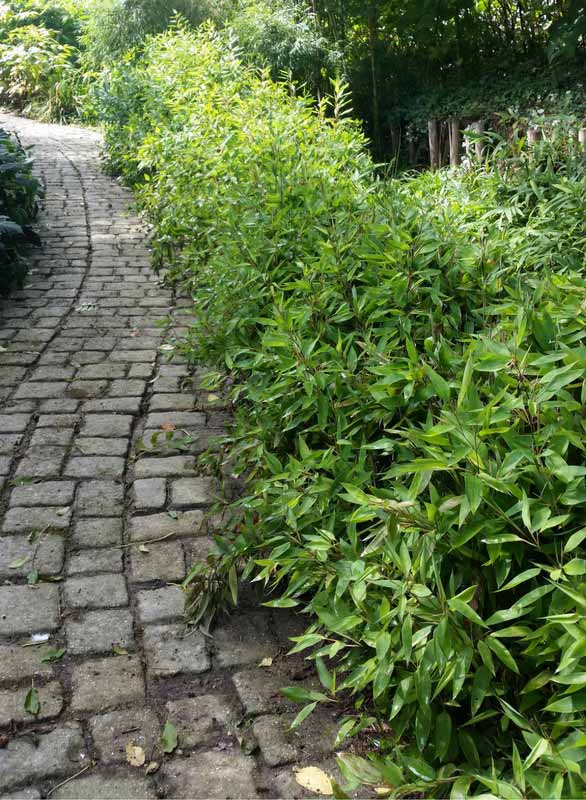
Comments